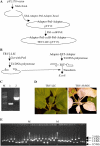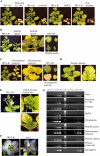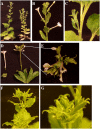A ligation-independent cloning tobacco rattle virus vector for high-throughput virus-induced gene silencing identifies roles for NbMADS4-1 and -2 in floral development
- PMID: 17932306
- PMCID: PMC2151726
- DOI: 10.1104/pp.107.107391
A ligation-independent cloning tobacco rattle virus vector for high-throughput virus-induced gene silencing identifies roles for NbMADS4-1 and -2 in floral development
Abstract
Virus-induced gene silencing (VIGS) is a widely used, powerful technique for reverse genetics. VIGS vectors derived from the Tobacco rattle virus (TRV) are among the most popular for VIGS. We have developed a TRV RNA2 vector that allows the insertion of gene silencing fragments by ligation-independent cloning (LIC). This new vector has several advantages over previous vectors, particularly for applications involving the analysis of large numbers of sequences, since TRV-LIC vectors containing the desired insert are obtained with 100% efficiency. Importantly, this vector allows the high-throughput cloning of silencing fragments without the use of costly enzymes required for recombination, as is the case with GATEWAY-based vectors. We generated a collection of silencing vectors based on 400 tomato (Solanum lycopersicum) expressed sequence tags in this TRV-LIC background. We have used this vector to identify roles for SlMADS1 and its Nicotiana benthamiana homologs, NbMADS4-1 and -2 in flowering. We find that NbMADS4-1 and -2 act nonredundantly in floral development and silencing of either gene results in loss of organ identity. This TRV-LIC vector should be a valuable resource to the plant community.
Figures






Similar articles
-
Virus-induced gene silencing in tomato.Plant J. 2002 Sep;31(6):777-86. doi: 10.1046/j.1365-313x.2002.01394.x. Plant J. 2002. PMID: 12220268
-
Optimization of Tobacco Rattle Virus (TRV)-Based Virus-Induced Gene Silencing (VIGS) in Tomato.Methods Mol Biol. 2022;2408:133-145. doi: 10.1007/978-1-0716-1875-2_9. Methods Mol Biol. 2022. PMID: 35325421
-
Virus-induced gene silencing (VIGS) in Nicotiana benthamiana and tomato.J Vis Exp. 2009 Jun 10;(28):1292. doi: 10.3791/1292. J Vis Exp. 2009. PMID: 19516240 Free PMC article.
-
The potential of virus-induced gene silencing for speeding up functional characterization of plant genes.Genet Mol Res. 2004 Sep 30;3(3):323-41. Genet Mol Res. 2004. PMID: 15614725 Review.
-
[Virus-induced gene silencing as a tool for analysis of gene functions in plants].Uirusu. 2010 Dec;60(2):155-62. doi: 10.2222/jsv.60.155. Uirusu. 2010. PMID: 21488329 Review. Japanese.
Cited by
-
Evolution of a plant gene cluster in Solanaceae and emergence of metabolic diversity.Elife. 2020 Jul 2;9:e56717. doi: 10.7554/eLife.56717. Elife. 2020. PMID: 32613943 Free PMC article.
-
Sprout vacuum-infiltration: a simple and efficient agroinoculation method for virus-induced gene silencing in diverse solanaceous species.Plant Cell Rep. 2012 Sep;31(9):1713-22. doi: 10.1007/s00299-012-1285-1. Epub 2012 Jun 21. Plant Cell Rep. 2012. PMID: 22717672
-
Identification of a BAHD acetyltransferase that produces protective acyl sugars in tomato trichomes.Proc Natl Acad Sci U S A. 2012 Oct 2;109(40):16377-82. doi: 10.1073/pnas.1207906109. Epub 2012 Sep 17. Proc Natl Acad Sci U S A. 2012. PMID: 22988115 Free PMC article.
-
Tissue-Specific RNA-Seq Analysis and Identification of Receptor-Like Proteins Related to Plant Growth in Capsicum annuum.Plants (Basel). 2021 May 13;10(5):972. doi: 10.3390/plants10050972. Plants (Basel). 2021. PMID: 34068172 Free PMC article.
-
Tropinone synthesis via an atypical polyketide synthase and P450-mediated cyclization.Nat Commun. 2018 Dec 11;9(1):5281. doi: 10.1038/s41467-018-07671-3. Nat Commun. 2018. PMID: 30538251 Free PMC article.
References
-
- Brigneti G, Martin-Hernandez AM, Jin H, Chen J, Baulcombe DC, Baker B, Jones JD (2004) Virus-induced gene silencing in Solanum species. Plant J 39 264–272 - PubMed
-
- Brodersen P, Voinnet O (2006) The diversity of RNA silencing pathways in plants. Trends Genet 22 268–280 - PubMed
-
- Burch-Smith TM, Anderson JC, Martin GB, Dinesh-Kumar SP (2004) Applications and advantages of virus-induced gene silencing for gene function studies in plants. Plant J 39 734–746 - PubMed
Publication types
MeSH terms
Substances
LinkOut - more resources
Full Text Sources
Other Literature Sources

